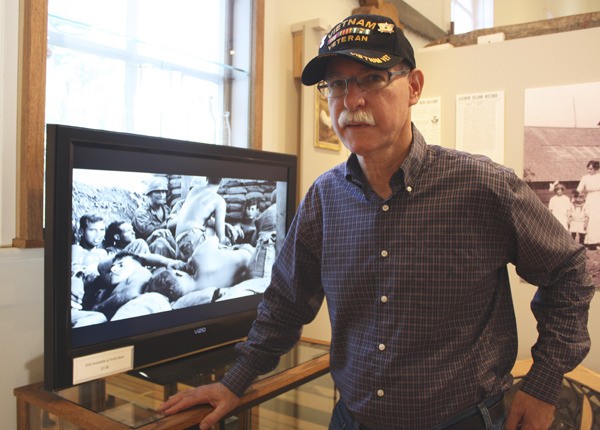Former Sgt. Christopher Gaynor spent the last 40 years trying to forget the trauma of the Vietnam War. A Vashon resident, he focused instead on his career as a bank asset administrator and then on managing the Parkinson’s Disease he developed as a result of his exposure to Agent Orange in Southeast Asia.
That is, until three years ago, when he met 17-year-old Boy Scout Tanner Means.
Tanner, then a junior at Vashon High School, heard that Gaynor had an extraordinary collection of photographs from his tour of Vietnam and approached him with a simple request: “Can I scan your pictures for my Eagle Scout project?”
For four decades Chris Gaynor had carried the photographic record of his combat experience inside a small, nondescript box. With every move he made, so came the box, the lid tightly sealed — sealed because he lacked the will to confront what lay inside. And then there was the young Scout’s request.
From January of 1967 through February of 1968, Chris Gaynor documented his tour of duty in Vietnam through the lens of his Asahi Pentax camera. His collection of more than 350 remarkable pictures captured the faces of South Vietnamese children, parents and grandparents, their villages and their homes. There were also countless pictures of his good friends and fellow soldiers that showed the hardship of separation and the hell of war. Yet the photos also portrayed the brightness of their youth, hope in a future and the bonds of brotherly love.
It was that fresh recollection of his Army buddies that prompted Gaynor to grant Tanner’s request.
Savvy with modern technology, Tanner began to scan the old images, struck, as he did so, by the faces in the photographs: These were guys his own age, and the dramatic contrast between his life and the lives of these soldiers was immediately apparent. Photograph after photograph showed young men standing next to barbed wired and sandbag barricades, jumping out of helicopters, lying in evac hospitals, braving the jungles and the heat and facing their own mortality. Time telescoped. Suddenly Tanner could read in the faces of the soldiers the reality of those days 40 years ago. What was just a vague idea from history books and television shows now lived and breathed as Tanner pored over the pictures.
“It was like standing in a museum, but this museum talked back to me,” he said.
Time passed, and then one day, a year after Tanner started his project, Chris Gaynor got a phone call from the young Scout. Tanner had completed his Eagle Scout project and wanted to show it to him. When the doorbell rang, a few days later, Gaynor was full of trepidation yet also optimistic that somehow something good would come of this, that this was all for a purpose.
He braced himself; it was too late to turn back now. And for the first time in more than 40 years, Gaynor laid eyes on those photos that had been sealed and forgotten in a box. What emerged from the freshly minted data disk on Tanner’s laptop was a striking visual tale. George and Perry, Freddie and Mikie — his closest pals in Vietnam — were suddenly there again, unchanged, in his living room on Vashon.
Chris Gaynor sat on his couch next to the future Eagle Scout, overcome with emotion. He broke down. Tanner, too, understood the significance of what he had brought into Gaynor’s living room and back into Gaynor’s life.
With his newly scanned photos out of the box and into the light, Gaynor’s purpose began to take shape. One morning earlier this year, as he stood in the middle of Ober Park, Gaynor read the names of Vashon’s 12 young men killed during the Vietnam War. Those names, engraved on two obelisks, were so much more tangible to him now: Frank Selden, Danny Barnes … Gaynor wanted to commemorate their lives … David Davies, William De Vore, David Hake… He needed to tell their story. … J. Athan Theodore, David Mace, Walter Ferrell. … These men of the military were Chris Gaynor’s brothers … John Stewart … his purpose … Donald Holke … and sadly Vashon’s contribution and enormous sacrifice to a much-maligned war. John Raaum, Larry Wallace.
And so, just as Tanner Means had approached Chris Gaynor a few years before, Gaynor approached Bruce Haulman, an historian and board member at the Vashon-Maury Island Heritage Museum. Haulman was moved by what he saw. And together they decided to create “Home of Record: Vashon and the Vietnam War” — the story of the Vietnam experience as told through Christopher Gaynor’s photographs.
One more precious piece was added to the exhibit, another trove that Gaynor carried inside that nondescript box: his letters home — letters read and reread, folded and unfolded, saved by a mother separated from her son so far away.
— Verna Everitt is a freelance writer. Christopher Gaynor and his partner of 36 years, Paul Chen, have been Vashon residents for 21 years
“Home of Record” opens from 6 to 9 p.m. Friday, Oct. 7, at the Vashon-Maury Island Heritage Museum. The exhibit includes Gaynor’s photographic record of the war, as well as many other features. There will be a “wall of remembrance,” providing visitors an opportunity to pay respects to the 12 men from Vashon who died in the war; an area where some of the sights and sounds of the war will be broadcast; and an interactive map of Vietnam, where veterans can identify where they served and Vietnamese-Americans can identify their family’s place of origin.



